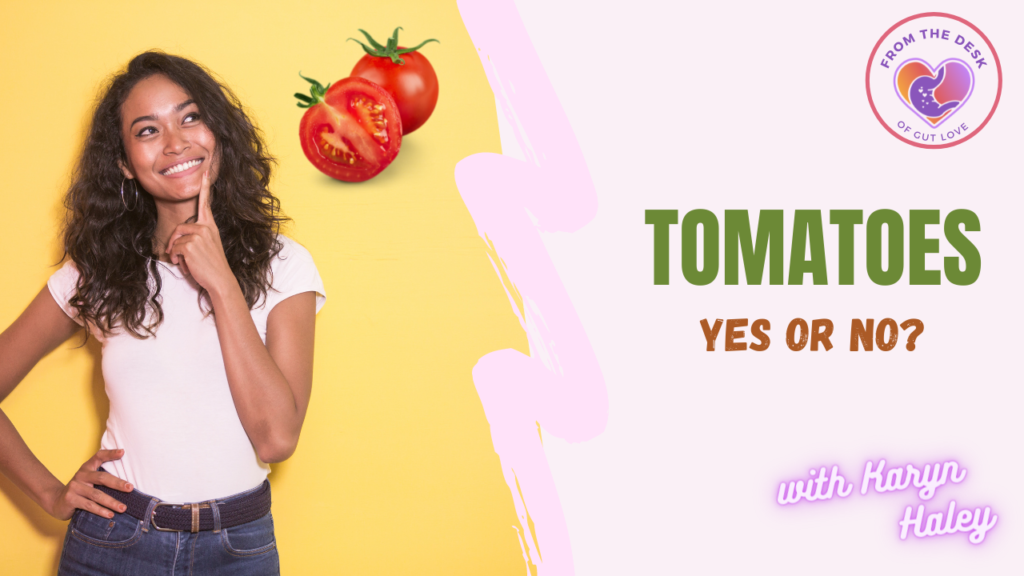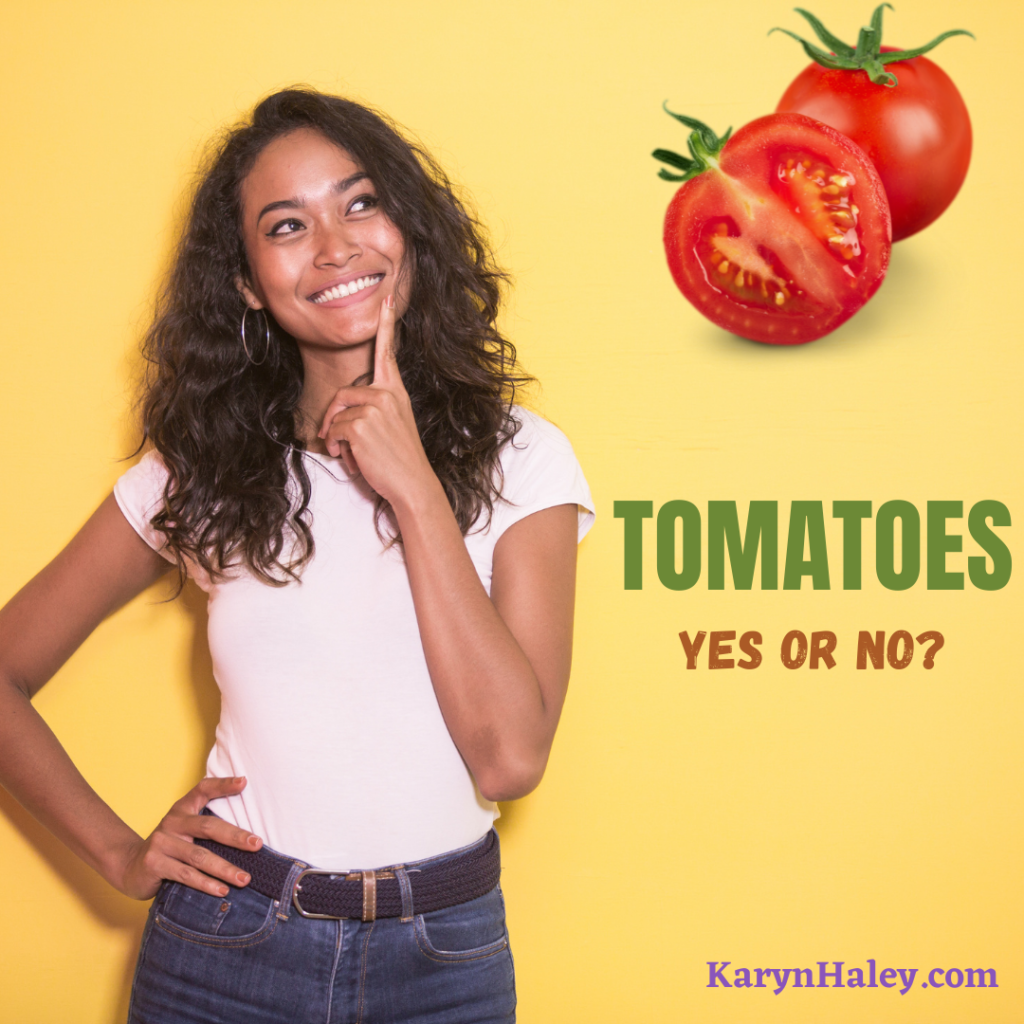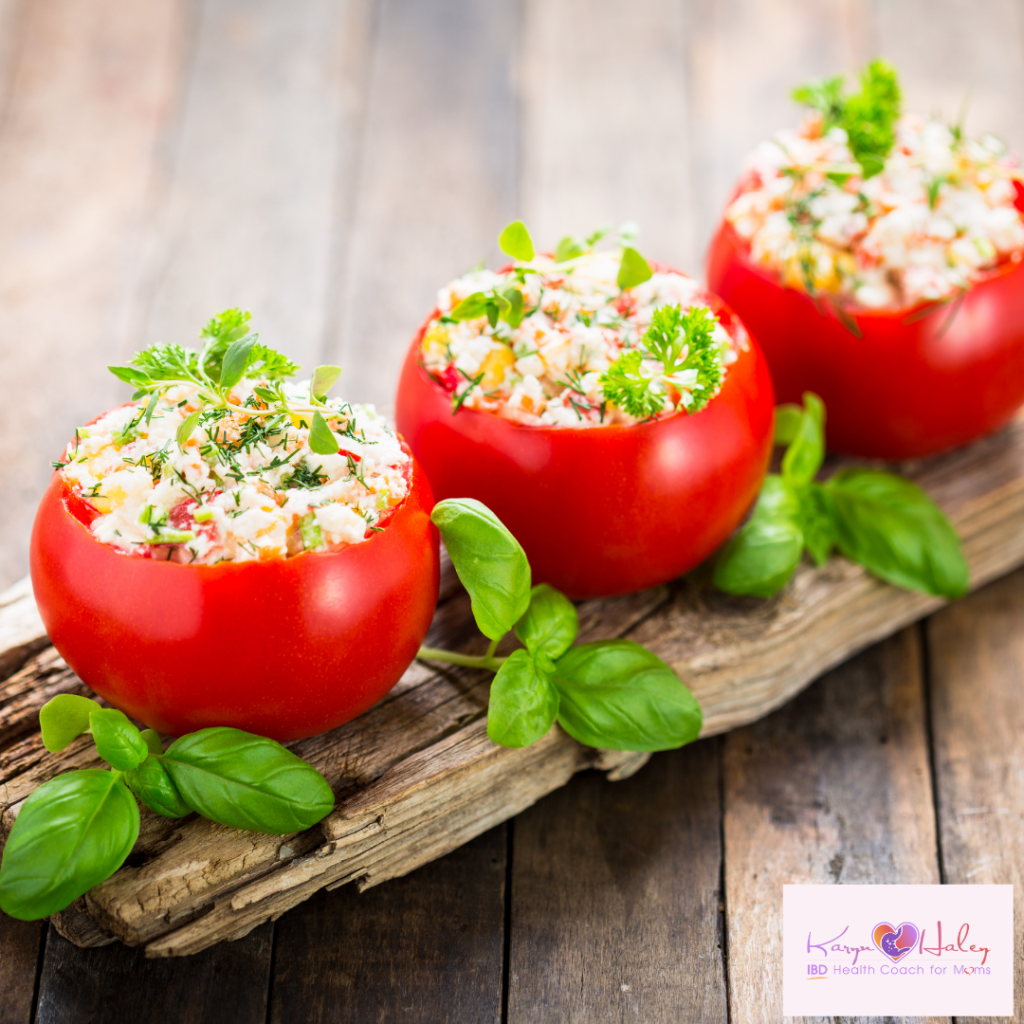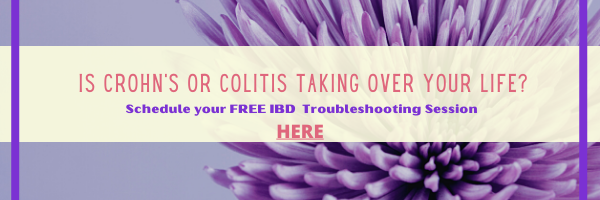
Tomatoes: Yes or No?
Do you eat tomatoes?
Raw, cooked, skin on, skin off, canned, tomato sauce, ketchup… although I’m not really sure ketchup qualifies as a tomato by that point.
Tomatoes are one of those things that some with Crohn’s and colitis eat with no issues and others run to the bathroom as soon as a tomato touches their lips.
I’m somewhere in the middle when it comes to tomatoes. I’ve had periods in my life when I’d eat raw tomatoes by the fist full.
No problems whatsoever.
But when my Crohn’s inflammation isn’t completely under control—Bam! Tomatoes are a go preceded by a no.
No way for the raw tomatoes.
One thing I most always seem to tolerate is tomato sauce and thank God, because my Italian family wouldn’t tolerate it if I didn’t eat my grandmother’s famous sauce recipe. And truth be told, I wouldn’t either because that sauce is heaven sent.
The secret to my Nana’s sauce (God rest her soul) was that she always added a touch of sugar to cut the acidity in the tomatoes. It definitely helped me tolerate her sauce when she made it. Now that I eat, sleep, and breath with my gut health in mind, I substitute out the sugar and replace it with honey.
Still works like a charm to cut some of the tomato-y acid that can give us heartburn, indigestion, acid reflux, and an upset belly.
If the jury is still out on you and tomatoes, or if you’re like me and you waver back and forth, you’re going to appreciate this post that’s all about tomatoes.
Hopefully, you’ll be able to take away some valuable, unbiased information on the benefits and the risks of tomato eating with IBD.
And if you choose to partake, I’m sharing a tomato inspired recipe at the end. It’s got a cooked and raw version so it will fit for wherever you’re at on your gut healing journey.
Four Things You’ll Learn in This Post
- Tomato health benefits specific to Crohn’s and colitis
- Why you might think you can’t eat tomatoes and how you can change that
- The reasons why tomatoes don’t work for everyone with IBD
- A gut healthy and delish tomato recipe that’s so easy you can make it today
Join our IBD mom tribe: The Gut Love Community of Moms

WHAT IS A TOMATO ANYWAY?
Fruit or Vegetable? Oh, the great tomato debate!
Why are we so set on putting produce in the wrong category? Tomatoes do have seeds so technically they’re a fruit, but for this post I’m going with vegetable. That’s what most of us call it anyway.
Just like in my Italian household where tomatoes were used liberally, tomatoes are at the heart of all Italian cuisine. In fact, Mediterranean’s alike love to use tomatoes whenever and wherever possible.
From paella to Greek salad, pizza to stews, tomatoes are incorporated into all sorts of dishes.
Tomatoes, part of the nightshade family, are believed to have originated in Mexico, but after the Spanish colonization of the Americas, tomato crops began popping up in a variety of places. Today, tomatoes are grown all over the world.
Tomatoes are an easy crop to plant, and when they grow, they proliferate like crazy. If you have a garden, you know tomatoes are one of those plants that grow with so much abundance that you’re either canning them for winter or giving them away to friends because you just can find a recipe for every batch you gather!
ARE TOMATOES REAL OR FAKE HEALTHY?
There’s lots to love about the nutritional make up of a tomato. They are really high in vitamins A, C, B, and K. But they are also glorious for their mineral make up with nutrients like magnesium, potassium, manganese, phosphorus, and copper.
That’s good news for all of us who are endlessly mineral deficient in America.
And if you are looking for fiber, tomatoes are a great option there too. With overall health benefits including heart health, better vision, lowering hypertension, better digestion, enhancing the skin, and reducing gallstones, tomatoes have a lot to brag about.
For this article, we’ll focus on the 3 main health benefits that are nearest and dearest to an IBDer’s heart:
- Digestion
- Heart health
- Gallbladder disease
Can tomatoes help my digestion?
Yes and no.
If you’re looking for some great ways to get more fiber in your diet, especially if constipation is your digestive challenge (it’s more common in IBD than you might think), look no further than tomatoes. The insoluble fiber in the skin can really help keep you regular.
On the other hand, that same fiber in the tomato skin (that’s where most of the fiber is located), can cause many of us with Crohn’s and colitis to have challenges digesting it.
Seen any tomato pieces in your poop lately? Yep, that’s your IBD body saying, “Nope, not gonna digest it!”
But even if you do struggle to digest tomatoes, don’t write them off so fast because remember, it’s not about whether you think can eat a tomato or not. It’s about putting that potentially healthy tomato in a form that your body can digest and absorb.
But I’ve got IBD. What’s the best way for me to digest tomatoes?
- Fresh pressed juice (add it to your juicer with some other veggies and fruit)
- Canned tomatoes (because there’s no skin so it’s easier to digest)
- Cooked tomatoes (because the fibers are broken down)
So go for it with tomatoes. Just be sure to put it in the best form for where your disease is at right now.
We can get so focused on our gut that we neglect our heart.
It’s easy to get side tracked with the digestive system. It rules everything we do from what we eat, to how we sleep, to the activities we are able to get involved with.
We may not even realize just how much our world is affected by the IBD colored glasses we wear. But next to our digestive system, the other big organ we’ve got to keep as healthy as possible is our heart.
That beautiful, blood pumping machine is vital to our overall health. Afterall, we don’t just function one organ at a time. We are a system that’s only as good as its weakest link. So keeping your heart healthy is just as important as our gut.
Tomatoes provide that heart healthy compound, lycopene.
One study found that eating foods high in lycopene was so important that it not only improved vascular function, it also played a role in preventing cardiovascular disorders. That’s because lycopene is an antioxidant with anti-inflammatory properties. When it comes to heart, the antioxidant lycopene been shown to be anti-hypertensive, shown to reduce in arterial stiffness, and reduce plaque in the heart.
And here’s the best part about heart healthy lycopene.
If you’re one of those IBDer’s who say, I guess I’ll miss out on all those lycopene benefits because I can’t digest raw tomatoes—this is one of the rare and awesome times I get to say that cooked is better.
You get more lycopene from cooked tomatoes than from raw.
So no worries if your belly isn’t up to raw tomatoes, cook them in a stew or in a sauce. Easier to digest and more lycopene for you!
How’s your gallbladder doin’?
You know how Joey from Friends is always saying, “How you doin’?” Well, for those of us with Crohn’s and colitis, the question should go like this, “How’s your gallbladder doin’?”
We have notoriously bad gallbladder issues.
Did you know that the risk of gallstones for those with Crohn’s is double the general population? Oh yeah, we’ve got the gallbladder market covered.
While many with IBD do end up having their gallbladder removed, I highly recommend you turn over every stone before letting that happen.
Once it’s removed, you can’t get it back and although doctors like to make light of a cholecystectomy (that’s the fancy name for gallbladder removal) and claim it’s not a big deal, trust me it is a big deal. Living without a gallbladder that’s so important for the release of bile to help us digest fat in the food we eat is crucial for those of us with a digestive disorder.
Studies show that a diet high in fruits and veggies is good for your gallbladder. Of the veggies recommended, tomatoes get high marks.
That’s because tomatoes are high in vitamin C, as well as loads of other vitamins and minerals. Tomatoes help your gallbladder function at its peak. So if gallbladder challenges are impacting you, look to the incredibly healthy and versatile tomato.
Of course, the tomato alone isn’t going to cure your gallbladder disease, but every little bit helps and tomatoes (raw or cooked) are ready to play a role in your overall health.
WHAT’S WRONG WITH TOMATOES FOR THOSE OF US WITH IBD?
For all that’s great about tomatoes, even for those of us with Crohn’s and colitis, there’s some things we need to keep in mind before diving in.
A little goes a long way.
When it comes to tomatoes and IBD (and for others as well), eating tomatoes in moderation is key.
You don’t want to go hog wild with tomatoes. Tomatoes are acidic by nature. So too many tomatoes can result in heartburn or a feeling of acid reflux or indigestion. If that happens, it’s a good idea to take a break from tomato consumption for a little while. Thirty days is a good recommended time to see if it makes a difference.
Trying again after a break is important too. It’s the best way to know if there’s a true cause between your love of tomatoes and the symptoms you’re having.
Skins and seeds may not be your friend.
Like I mentioned earlier, eating tomatoes and feeling well after may be all about how you prepare and eat those tomatoes.
Raw and fresh, isn’t the only way to eat a tomato.
People with IBD, especially those who are not in remission, are going to do better with tomatoes that are in fresh pressed juice, ones that are canned, and tomatoes that have been cooked. Cooking breaks down the fiber and reduces the acidic nature of the tomato.
The skin and the seeds are the hardest part of the tomato to digest. Once these components are broken down, tomatoes are much easier to digest and absorb.
And think of all that healthy lycopene you’re absorbing too.
Be careful of over processed tomato products like ketchup and sauces with sugar or additives. These can be just as harmful to our bellies as raw tomatoes. Look for tomato products in their natural state. Either grow and can your own, or choose organic, minimal ingredient products like Bionaturae, Raos, and Muir Glen.
There’s more than one creeper out at night: Nightshades
We can’t conclude our conversation about the potential challenges IBDer’s might have with tomatoes without mentioning nightshade intolerance. Many people living with Crohn’s and colitis are sensitive to a certain type of produce called nightshades. Examples of nightshades include:
- Tomatoes
- White potatoes
- Peppers
- Eggplant
- Chilies
- Some spices like cayenne pepper and paprika.
If you don’t tolerate these foods, a nightshade intolerance could be the culprit.
Why does this impact IBDer’s so much?
Well, one of the hallmarks of Crohn’s and colitis is food sensitivities. Many of us with IBD have them, but we aren’t sure which foods bother us, especially when our disease is in an active state.
When we’re in a flare-up it might seem like everything bothers you. But the truth is, we all have specific foods that don’t work for our sensitive bodies. Nightshades could be one of those foods for you.
How do I know if nightshades bother me?
Here’s a list of common nightshade reactions:
- Arthritis/joint pain
- Hives/skin rashes
- Inflammation
- Achy muscles
- Bloating and gas
- Heartburn
- Itching
- Excessive mucus
If you suspect a nightshade intolerance, it’s probably best to stay away from tomatoes for now.
Maybe a 30-day trial run without them could help you see if you have a problem. If you find that your sensitivity is mild, some things that help are not eating the skin of nightshades as well as cooking them first.
See, there’s another reason why it’s OK to cook your tomatoes.
Whether tomatoes bother you a little or a lot, there’s a phrase my clients will tell you I often say, “This is your now, it’s not your forever.” You never know. Tomatoes may come your way again down the line. Sometimes your body just needs a break to reset and recalibrate.
Only time will tell what your future holds between you and tomatoes. (sounds like relationship advice, doesn’t it ; )
So, what do you think about tomatoes? Yes, no, or somewhere in the middle?
Let me know in the comments below this post.
One last and really cool thing I have to tell you about the pros and cons of tomatoes for an IBD belly–
Keep in mind that your decision about tomatoes doesn’t have to be 100% yes or 100% no.
Sensitivities come in all shapes and sizes and there’s a continuum to all of this with, “Oh yes, I eat them all the time,” at one end of the spectrum. All the way to, “Mmm, sometimes I partake,” in the middle of the bell curve. To, “Hell to the no, never ever never no” all the way on the other side.
Figuring out where you’re at may take some time and patience, but I think with all the health benefits tomatoes offer, it’s worth figuring out what your relationship with tomatoes should be. And if the answer ends up being a solid no, don’t sweat it. There’s so many healthy foods on the planet just waiting for you to indulge in.
Ready to find out if tomatoes are in your wheel of wellness?
CHECK OUT MY TOMATO INSPIRED RECIPE BELOW.
It’s bound to wet your tastebuds and jump start your health. And guess what? For IBD gals who struggle with raw (me, me!!) there’s a cooked version as well so whether you’re a raw tomato girl or a cooked tomato fan, you’ll love everything about this dish.
CHICKEN SALAD STUFFED TOMATOES

Ingredients:
Prepared chicken salad (see recipe below)
3 large tomatoes
Fresh grated parmesan cheese
Extra virgin olive oil
Balsamic vinegar
Directions:
Cut ½ inch off the top of each tomato. Scoop out the pulp.
Turn the tomatoes upside down on a paper towel to drain excess water while you prepare the chicken salad.
Once the chicken salad is prepared, place the filling in the tomatoes. Sprinkle with cheese. Drizzle oil and vinegar on the top and serve.
*Digestion tip: if raw tomatoes don’t agree with your belly, this recipe can easily bake in the oven and be served warm. Heat oven to 350 degrees F. Place tomatoes on a baking tray lined with aluminum foil. Bake in the oven for 15-20 minutes. Serve warm. Avoid eating any seeds and skin.
Chicken Salad
*Use the ingredients that work for your belly, get rid of the rest, keeping in mind you can always cook ingredients to break down the fiber and make them easier to digest.
2-3 pieces of cooked chicken, chopped or shredded
¼ cup celery, minced
1 Tbsp onion, minced
1 hard-boiled egg, chopped
8 green olives, chopped
8 red grapes, chopped
1 Tbsp slivered almonds
Sea salt and pepper to taste
Optional:
Top with fresh or dried herbs like basil, oregano, parsley or thyme
Resources To Take the Conversation Further:
10 Science-Based Health Benefits Of Tomatoes
Cooking Tomatoes Boosts Disease-Fighting Power
Is Gallstone Disease Associated with Inflammatory Bowel Disease?
What to Know About Nightshade Intolerance
Connect With Karyn:
Schedule Your FREE 30-Minute IBD Consult
These statements have not been evaluated by the Food and Drug Administration.
This podcast, video, and blog post is not intended to diagnose, treat, cure, or prevent any disease.
Podcast: Play in new window | Download


